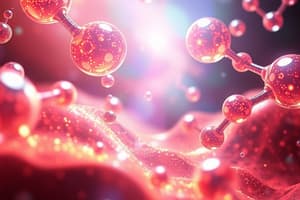Podcast
Questions and Answers
What is the required HLB of the oil phase when combining soybean oil and cetyl alcohol?
What is the required HLB of the oil phase when combining soybean oil and cetyl alcohol?
- 8.75
- 11.50
- 10.00
- 9.13 (correct)
What does the variable Γ represent in Gibbs' equation?
What does the variable Γ represent in Gibbs' equation?
- Surface excess concentration (correct)
- Surface tension
- Thermodynamic temperature
- Bulk concentration
What is the result of increasing surfactant concentration in a solution before reaching the critical micelle concentration (cmc)?
What is the result of increasing surfactant concentration in a solution before reaching the critical micelle concentration (cmc)?
- Increased surface tension
- Significant fall in surface tension (correct)
- Dynamic equilibrium of monomers
- Formation of solid aggregates
What happens to surfactant molecules above the critical micelle concentration (cmc)?
What happens to surfactant molecules above the critical micelle concentration (cmc)?
What is the bulk concentration denoted as in the Gibbs adsorption equation?
What is the bulk concentration denoted as in the Gibbs adsorption equation?
What does the critical micelle concentration (cmc) indicate?
What does the critical micelle concentration (cmc) indicate?
How is the available area per molecule calculated from surface excess concentration (Γ)?
How is the available area per molecule calculated from surface excess concentration (Γ)?
Which statement accurately describes surfactant behavior at the surface?
Which statement accurately describes surfactant behavior at the surface?
What is the primary reason hydrophobic groups tend to withdraw from the aqueous phase in surfactants?
What is the primary reason hydrophobic groups tend to withdraw from the aqueous phase in surfactants?
Which factor determines the solubility of surfactants in an aqueous solution?
Which factor determines the solubility of surfactants in an aqueous solution?
How do surfactant molecules behave when added to water?
How do surfactant molecules behave when added to water?
What occurs to the surface tension of a liquid when surfactants are added?
What occurs to the surface tension of a liquid when surfactants are added?
Why are ionic and polar materials soluble in water?
Why are ionic and polar materials soluble in water?
What is the effect of increasing the length of the hydrocarbon chain in surfactants?
What is the effect of increasing the length of the hydrocarbon chain in surfactants?
Which of the following statements best describes the structure of water molecules?
Which of the following statements best describes the structure of water molecules?
What occurs when non-polar regions interact with water?
What occurs when non-polar regions interact with water?
What does a high HLB value indicate about a surfactant?
What does a high HLB value indicate about a surfactant?
Which HLB range is associated with poor solubility?
Which HLB range is associated with poor solubility?
How is the HLB of a surfactant calculated?
How is the HLB of a surfactant calculated?
What does a required HLB of 7 for soybean oil suggest about suitable emulsifiers?
What does a required HLB of 7 for soybean oil suggest about suitable emulsifiers?
If the hydrophilic part of a non-ionic surfactant is calculated as 281 and the total mass is 422, what is the HLB value?
If the hydrophilic part of a non-ionic surfactant is calculated as 281 and the total mass is 422, what is the HLB value?
Which of the following is a characteristic of emulsifiers with an HLB of 8-10?
Which of the following is a characteristic of emulsifiers with an HLB of 8-10?
In an oil phase containing 15% soybean oil and 5% cetyl alcohol, what is the weight percentage of soybean oil in the oil phase?
In an oil phase containing 15% soybean oil and 5% cetyl alcohol, what is the weight percentage of soybean oil in the oil phase?
What happens to the contractile nature of a solution when surfactants are added?
What happens to the contractile nature of a solution when surfactants are added?
What occurs when the concentration of surfactants is too high?
What occurs when the concentration of surfactants is too high?
Which type of surfactant generally forms micelles at lower concentrations?
Which type of surfactant generally forms micelles at lower concentrations?
What is the effect of increasing the chain length of the hydrophobic group in surfactants?
What is the effect of increasing the chain length of the hydrophobic group in surfactants?
Which of the following has a higher critical micelle concentration (cmc)?
Which of the following has a higher critical micelle concentration (cmc)?
What defines the shape of non-ionic micelles compared to ionic micelles?
What defines the shape of non-ionic micelles compared to ionic micelles?
What does an increase in the hydrophilic portion of a surfactant molecule result in?
What does an increase in the hydrophilic portion of a surfactant molecule result in?
How does the presence of bound counter ions affect ionic micelles?
How does the presence of bound counter ions affect ionic micelles?
What is the relationship between the aggregation number and cmc in non-ionic surfactants?
What is the relationship between the aggregation number and cmc in non-ionic surfactants?
What effect does the addition of electrolytes have on ionic micelles?
What effect does the addition of electrolytes have on ionic micelles?
At what condition do non-ionic surfactants typically become cloudy?
At what condition do non-ionic surfactants typically become cloudy?
What is the Krafft point related to regarding ionic surfactants?
What is the Krafft point related to regarding ionic surfactants?
How does the presence of bound counter ions influence ionic micelles?
How does the presence of bound counter ions influence ionic micelles?
What happens to the conductivity of ionic micelles during micellization?
What happens to the conductivity of ionic micelles during micellization?
What role do larger mass counter ions play in micellar systems?
What role do larger mass counter ions play in micellar systems?
What is the significance of the critical micelle concentration (cmc)?
What is the significance of the critical micelle concentration (cmc)?
How does temperature affect the solubility of ethoxylate surfactants?
How does temperature affect the solubility of ethoxylate surfactants?
Flashcards
Surface Excess Concentration (Γ)
Surface Excess Concentration (Γ)
The concentration of a surfactant at the interface, exceeding what would be present if the bulk concentration extended to the surface.
Dynamic Equilibrium
Dynamic Equilibrium
A dynamic equilibrium exists between surfactant molecules at the surface and in the bulk solution. This means there's a constant exchange between the surface and the bulk.
Gradient of Surface Tension vs. Bulk Concentration (dγl/v/dCb)
Gradient of Surface Tension vs. Bulk Concentration (dγl/v/dCb)
The change in surface tension (γl/v) as the bulk concentration (Cb) changes.
Micelle Formation
Micelle Formation
Signup and view all the flashcards
Critical Micelle Concentration (cmc)
Critical Micelle Concentration (cmc)
Signup and view all the flashcards
Solubilization
Solubilization
Signup and view all the flashcards
Surfactant Adsorption
Surfactant Adsorption
Signup and view all the flashcards
Surface Activity
Surface Activity
Signup and view all the flashcards
Amphipathic Molecules
Amphipathic Molecules
Signup and view all the flashcards
Surfactants
Surfactants
Signup and view all the flashcards
Surface Tension
Surface Tension
Signup and view all the flashcards
Adsorption
Adsorption
Signup and view all the flashcards
Solubility
Solubility
Signup and view all the flashcards
Water-Water Attractive Forces
Water-Water Attractive Forces
Signup and view all the flashcards
Water-Hydrocarbon Attractive Forces
Water-Hydrocarbon Attractive Forces
Signup and view all the flashcards
Hydrocarbon-Hydrocarbon Attractive Forces
Hydrocarbon-Hydrocarbon Attractive Forces
Signup and view all the flashcards
HLB (Hydrophilic-Lipophilic Balance)
HLB (Hydrophilic-Lipophilic Balance)
Signup and view all the flashcards
HLB > 13
HLB > 13
Signup and view all the flashcards
HLB 8-10
HLB 8-10
Signup and view all the flashcards
HLB 6-8
HLB 6-8
Signup and view all the flashcards
HLB 3-6
HLB 3-6
Signup and view all the flashcards
HLB 1-3
HLB 1-3
Signup and view all the flashcards
Required HLB
Required HLB
Signup and view all the flashcards
Emulsifier Selection
Emulsifier Selection
Signup and view all the flashcards
What is CMC?
What is CMC?
Signup and view all the flashcards
What are micelles?
What are micelles?
Signup and view all the flashcards
Why do micelles form?
Why do micelles form?
Signup and view all the flashcards
How do non-ionic and ionic surfactants differ in micelle formation?
How do non-ionic and ionic surfactants differ in micelle formation?
Signup and view all the flashcards
What factors influence the size and shape of micelles?
What factors influence the size and shape of micelles?
Signup and view all the flashcards
How does the structure of the hydrophobic and hydrophilic groups affect the CMC?
How does the structure of the hydrophobic and hydrophilic groups affect the CMC?
Signup and view all the flashcards
How does the length of the polyoxyethylene chain affect the CMC in non-ionic surfactants?
How does the length of the polyoxyethylene chain affect the CMC in non-ionic surfactants?
Signup and view all the flashcards
What is the aggregation number, and how does it differ between ionic and non-ionic surfactants?
What is the aggregation number, and how does it differ between ionic and non-ionic surfactants?
Signup and view all the flashcards
Counter ion effect on micelles
Counter ion effect on micelles
Signup and view all the flashcards
Electrolyte effect on micelles
Electrolyte effect on micelles
Signup and view all the flashcards
Cloud point of non-ionic surfactants
Cloud point of non-ionic surfactants
Signup and view all the flashcards
Krafft point of ionic surfactants
Krafft point of ionic surfactants
Signup and view all the flashcards
Determining CMC through conductivity
Determining CMC through conductivity
Signup and view all the flashcards
Conductivity of ionic micelles
Conductivity of ionic micelles
Signup and view all the flashcards
Solubilization by micelles
Solubilization by micelles
Signup and view all the flashcards
Counter ion effect on conductivity
Counter ion effect on conductivity
Signup and view all the flashcards
Study Notes
Surfactant Activity & Application
- Surfactants are amphipathic molecules, possessing both hydrophobic and hydrophilic groups.
- Hydrophobic groups (typically carbon chains) repel water, while hydrophilic groups (often ionic or polar) attract water.
- Water's structured arrangement due to hydrogen bonding can be disrupted by solutes.
- Surfactants compensate for this disruption, allowing ionic and polar materials to readily dissolve in water.
- Non-polar substances do not readily dissolve in water as there is no compensating force for disruption of water structure.
- Solubility with surfactants depends on the polar group's effectiveness in bonding with water to counteract hydrophobic repulsion.
- Surfactant molecules orient at interfaces, with hydrocarbon chains facing away from the aqueous phase.
- The longer the surfactant hydrocarbon chain, the more energetically favorable adsorption at surfaces/interfaces is. This leads to higher surfactant concentration at the surface.
- Surfactant adsorption reduces surface tension.
- The HLB (hydrophilic-lipophilic balance) value indicates the surfactant's relative affinity for oil or water; low HLB suggests greater oil solubility.
- Different HLB ranges correspond to different surfactant applications; e.g., HLB values ≥13 are for solubilization, while 8-10 suggest o/w emulsification.
- The HLB system relates all fats and oils to a required HLB value.
- Appropriate emulsifiers or blends thereof are selected based on the required HLB of the oil phase.
- Gibbs derived an equation to calculate the extent of surfactant adsorption.
- Surface excess concentration accounts for surfactant in excess of that present if the bulk phase extended to the surface.
- Calculation of the available surface area per molecule involves considerations of the surface excess concentration, Avogadro's number and bulk concentration.
- Although some surfactant is at the surface, most is within the bulk of the solution.
- The addition of surfactants leads to a significant reduction in surface tension, followed by a less pronounced decrease as the critical micelle concentration (cmc) is reached.
- Micelles are aggregates of surfactant molecules at concentrations above the cmc.
- The formation of micelles occurs to reduce the surface area and thus the free energy of the system.
- The structure of the hydrophobic group affects cmc and micelle size; longer chains result in a decreased cmc and a larger micelle size.
- The hydrophilic group also impacts cmc; a larger hydrophilic group results in an increased cmc.
- Non-ionic surfactants have lower cmc and higher aggregation numbers than ionic surfactants.
- The addition of electrolytes to ionic micelles decreases micelle size, reducing the repulsive forces between head groups.
- At higher temperatures, solutions of some surfactants can become cloudy; conversely, solubility can decrease, this may be due to micellization.
- The Krafft point represents the temperature above which the solubility of ionic surfactants significantly increases.
Micelle Formation
- Micelle formation minimizes the system's free energy.
- Water structuring around the hydrophobic group is energetically unfavorable.
- Molecules self-aggregate for optimal packing of the hydrophobic groups, in minimizing contact with water.
- Molecules in micelles exhibit freedom of movement compared to those constrained by water structure.
- Micelle formation is dynamic; micelles continually break down into monomers and reform.
- Non-ionic surfactants form micelles at lower concentrations than ionic surfactants.
- Ionic micelles are spherical, with approximately 70-80% counter ions bound to them.
- Non-ionic micelles are much larger than ionic micelles and are often asymmetrical, typically ellipsoidal in shape.
- Oxyethylene groups in some non-ionic surfactants hydrate and entrap water within the micelles.
Factors Affecting CMC & Micelle Size
- Chain length: increase in chain length leads to a decrease in CMC and an increase in micelle size.
- Hydrophilic group: an increase in the hydrophilic portion leads to an increase in cmc.
CMC Determination
- Plot conductivity versus surfactant concentration.
- Two linear phases are observed, with a less steep second phase above the critical micelle concentration (cmc).
Electrical Conductivity of Ionic Micelles
- Movement of ions is affected by solvent drag, and micellization reduces drag, meaning it should increase conductance.
- Ionic atmosphere around micelles breaks down water structuring, meaning it should decrease conductance.
- Bound counter-ions reduce overall charge, reducing the flow of counter ions and affecting conductance.
Studying That Suits You
Use AI to generate personalized quizzes and flashcards to suit your learning preferences.


![Pharmaceutical Engineering: Surfactants I [PHENt 203]](https://images.unsplash.com/photo-1580982172477-9373ff52ae43?crop=entropy&cs=srgb&fm=jpg&ixid=M3w0MjA4MDF8MHwxfHNlYXJjaHw1fHxzdXJmYWN0YW50cyUyQyUyMHBoeXNpY2FsJTIwcGhhcm1hY3klMkMlMjBwaGFybWFjZXV0aWNhbCUyMGVuZ2luZWVyaW5nfGVufDF8MHx8fDE3MTgxODE0MjJ8MA&ixlib=rb-4.0.3&q=85&w=300&fit=crop&h=200&q=75&fm=webp)


